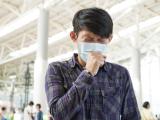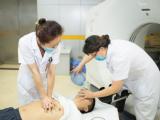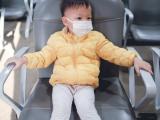Mar 21, 2003 (CIDRAP News) – Suspected US cases of severe acute respiratory syndrome (SARS) climbed to 22 today as the global total neared 360, the Centers for Disease Control and Prevention (CDC) reported.
The US total now includes three patients who didn't travel to Southeast Asia, the epicenter of the outbreak, but apparently caught the illness from close contacts who had traveled there, CDC Director Dr. Julie Gerberding said at an afternoon news briefing.
"One individual who traveled to Asia may have been the source of transmission of infection to two healthcare workers," Gerberding said. Another person who had been in Asia may have been the source of infection in a family member, she added. Until now, all the suspected US cases of the mysterious respiratory disease have been in people who had recently been in Asia.
Gerberding said the World Health Organization (WHO) today reported 337 suspected cases of SARS in 14 countries other than the United States, bringing the world total to 359, with 10 deaths. That total is up from 264 two days ago and 306 yesterday. The US cases are in 12 states, Gerberding said. More than half of all cases worldwide—203—are in Hong Kong.
The cause of the disease remains unknown, though two laboratories have found evidence via electron microscopy that it may be a member of the Paramyxovirus family, as reported earlier this week. Today, WHO reported that one laboratory, which was not named, has succeeded in growing in cell culture an infectious agent that may be the cause of SARS.
Serum from patients with a viral infection usually contains antibodies that will stop the growth of the virus when added to a cell culture in which the virus has been successfully grown, WHO noted in a news release. Therefore, researchers at the lab took serum samples from recovering SARS patients and from a matching number of healthy people and added them to cell cultures containing the unknown virus, the WHO statement said. "When the researchers added serum from SARS patients to the cell culture, virus growth was halted. Serum from uninfected healthy controls had no effect on the virus."
WHO called this achievement "a major step toward the development of a diagnostic test," but cautioned that the number of patients in the experiment was small and more work is needed. Gerberding, meanwhile, said investigators are not even sure yet that the pathogen is a virus, and added that it's very unlikely that a diagnostic test can be devised until the pathogen is identified.
While labs in Germany and Hong Kong have identified particles that appeared to be pParamyxoviruses, some other labs "have evidence that they are seeing something that doesn't look quite like a paramyxovirus," Gerberding said today.
The indications of a paramyxovirus have come primarily from nasal specimens. But Larry Anderson, MD, chief of the CDC's respiratory and enterovirus branch, said one lab, which he didn't name, reported finding "paramyxovirus-like particles in serum or a blood test."
While the race to identify the pathogen continues, the CDC is busy alerting travelers from the affected regions about the disease and even escorting some ill passengers directly to hospitals on their return to the United States, officials said. The agency has distributed 35,000 health alert cards to arriving travelers in the past few days and has intercepted "more than five planes or boats" with sick passengers, Gerberding said.
"More than 50 flights a day are being met," said Marty Cetron, MD, deputy director of the CDC division of global migration and quarantine. All the arriving passengers get a card advising them to call their healthcare provider immediately if they get a fever or respiratory symptoms within a week of the day they left Asia.
If a passenger has suggestive symptoms en route and the CDC is notified in time, a quarantine inspector is sent to meet the person on arrival, put a mask on him or her, and take him or her to a healthcare facility, Cetron said. Healthy passengers from the same flight are asked to tell where they can be reached for the next 14 days, and the CDC plans to follow up with them during that time, he said.
Most SARS cases so far have been in healthcare workers and household contacts of patients. The CDC has been advising stringent infection control measures to prevent spread in healthcare settings, including standard precautions, airborne precautions (negative-pressure rooms and N-95 respirators), and contact precautions (gowns and gloves). In addition, in this week's Morbidity and Mortality Weekly Report, the agency advises healthcare workers to wear eye protection.
Evidence about the virulence and transmissibility of SARS is confusing. Some of the patients who developed severe pneumonia were middle-aged people who were previously relatively healthy, which suggests that the disease can be very virulent, Gerberding said. And attack rates of more than 50% have been seen in healthcare workers caring for SARS patients, according to MMWR.
However, an MMWR Dispatch issued today states, "The severity of illness might be highly variable, ranging from mild illness to death. Although a few close contacts of patients with SARS have developed a similar illness, the majority have remained well. Some close contacts have reported a mild, febrile illness without respiratory signs or symptoms, suggesting the illness might not always progress to the respiratory phase."
In addition, Gerberding cited reports of SARS patients being released from hospitals, suggesting that "good supportive care can get people through the crisis and they can recover."
The MMWR Dispatch, a preliminary clinical description of SARS, says most patients have been between the ages of 25 and 70 and were previously healthy. The disease is severe enough to require mechanical breathing in 10% to 20% of cases, and the case-fatality rate is about 3%.
Gerberding said CDC is "keeping an open mind about terrorism" as a possible cause of the SARS outbreak. "All indications are that this is a naturally occurring disease, but we're not ruling out any possibilities before we pin down the actual source," she said.
See also:
MMWR general report on SARS outbreak
http://www.cdc.gov/mmwr/preview/mmwrhtml/mm5211a5.htm
WHO report on progress toward a diagnostic test
http://www.who.int/csr/don/2003_03_21/en/
WHO case count
http://www.who.int/csr/sarscountry/2003_03_21/en/




















